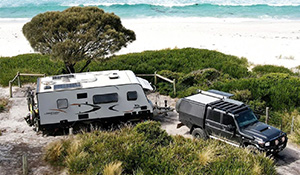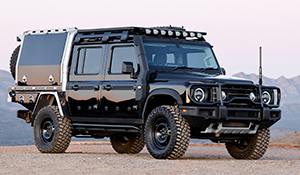Holden relaunched the Frontera 4x4 in 1999
Five years in the planning, the Isuzu-designed four-wheel drive was bigger, repowered and a substantially better vehicle all round. Interestingly it was designed in Japan, used right hand drive components manufactured in Europe, and assembled in the USA.
The new Frontera replaced the Frontera Sport with four models - three five-door V6 models and a three-door with 2.2-litre four cylinder engine.
Holden pitched it as a 'lifestyle' 4x4 vehicle, saying, "Frontera is a sporty four-wheel-drive for people who lead diverse lifestyles." So it may, but the same could be said about the Frontera's competition!
The Frontera was well equipped and competitively priced. The basic five-door wagon with V6 power was priced at $35,990, while the top of the range Frontera SE was $42,990. The four-cylinder three-door Frontera was priced at $29,990.
Holden heeded criticism of the superseded Frontera and delivered a vehicle that addressed key problem areas. This time round the Frontera did not want for power, with the V6 providing plenty of get up and go. Similarly, five doors are nearly a prerequisite for a family wagon; and inside it was replete with plenty of convenient, value-adding items. Standard features on all models included ABS brakes, driver and passenger airbags, air-conditioning, power windows, and off-road tuned suspension.
Frontera Models
The four Frontera models - three five-door and the single Frontera Sport three-door model - were all fully featured with air-conditioning, ABS brakes, power windows and mirrors, and dual airbags across the range.
For four-wheel driving, all Frontera models were equipped with a 'shift on the fly' 2WD/4WD High button, that could be selected at speeds up to 100 km/h.
A 3.2-litre 24 valve ISUZU V6 engine that produced 151kW of power and 290Nm of torque powered the five-door models.
The three-door Frontera Sport had the Australian HEC Family II four-cylinder engine, with 96kW of power and 195Nm of torque.
The three five-door models were the base model Frontera ($35,990), the Frontera S ($38,990) and the top of the range Frontera SE with auto transmission ($42,990).
All Frontera models came equipped with high-back, reclining seats and headrests; the three-door model with 50/50 split bench rear seats; and five-door models with a 60/40 split seat back and cushion.
Shoulder belt height adjusters were standard on passenger seats, as were map pockets behind both front seats. Rear seats had a seatbelt pretensioning system for improved restraint of child safety seats.
Standard gear on all Frontera models included power windows, four-spoke steering wheel, colour-keyed carpets, driver's footrest, centre and rear consoles and full door trim with cloth inserts. The standard Eurovox AM/FM stereo radio/cassette had six speakers. Remote keyless entry was standard on all models. The rear door was hinged on the left-hand side, with fixed glass on the three-door model. Five door models came with a flip-up hatch glass on the upper section of the rear door, and all Frontera models had a netted pocket inside the rear door.
The Frontera SE featured an overhead console with reading lights and storage area.
Additional equipment in the 'S' model Frontera was cruise control, limited slip differential, fog lights and single CD player and 15-inch alloy wheels.
The top of the range SE model gained leather wrap steering wheel, better quality cloth trim, overhead console, automatic climate control and colour-keyed bumpers, mirrors and door handles, and tilt adjustable steering column. The power door lock system also automatically locked or unlocked the tailgate, and the fuel filler lid was integrated with the door locks.
Frontera Powerplants
3.2-litre Isuzu V6 engine
Standard powertrain on all Frontera five-door models was the new V6 engine. It was a retuned version of the Rodeo's proven power plant and a derivative of the 3.5-litre unit used in the Holden Jackaroo. The 3.2-litre Isuzu V6 produced peak power of 151kW at 5400 rpm, and 290Nm of torque at 3000 rpm.
The Frontera 3.2-litre V6 was an all-aluminium alloy, cross-flow engine with four valves per cylinder, and direct acting, gear-driven double overhead camshafts. The engine's sequential multi-point fuel injection system allowed the injection of fuel onto the inlet valve of each cylinder; heat is drawn from the valve to vapourise the fuel before it is drawn into the cylinder. This resulted in improved combustion - particularly at idle - resulting in improved idle stability and reduced exhaust emissions. The high-energy electronic ignition featured six newly-designed integrated coil modules. Each was attached directly to its respective spark plug, eliminating the separate ignition module and high-tension wiring found on conventional spark plug ignition systems.
The camshafts were gear-driven, the gear drive featuring scissor gears for elimination of gear backlash for quieter operation. The camshafts acted directly on the valves, enabling a compact cylinder head design with fewer moving parts. Friction was reduced, contributing to improved fuel efficiency.
2.2-litre HEC 4-cylinder engine
The 2.2-litre Australian HEC 4-cylinder petrol engine in the Frontera Sport three-door developed 96kW of power at 5200 rpm and 195Nm of torque at 4000 rpm. Features included direct ignition and sequential multi-point fuel injection. The twin overhead camshaft design with four valves per cylinder developed more power and torque than the previous Frontera 2.0-litre engine.
Transmissions
The Frontera Sport three-door, Frontera and Frontera S came equipped with a five-speed manual transmission with overdrive. The Frontera SE had an electronically controlled four-speed automatic transmission with overdrive as standard. Features of this transmission were a driver-selectable power mode, third gear winter start mode and adaptive shift pressure. A brake/transmission shift interlock was standard with automatic transmission - the interlock being a safety device requiring the driver to apply the brake pedal to shift from park.
Drive experience
The 1999 Frontera was a quantum leap over and above its predecessor, but still missed the mark as a genuine SUV alternative. The V6 was a dependable engine, but lacked low down punch.
While build quality was fine and equipment levels generous, general handling and responsiveness were poor. Ride quality was poor, especially over corrugated roads, and the anti-skid brakes were not suited for local conditions (these were later replaced).
For four-wheel driving the Frontera had minimal ground clearance and the locally set-up suspension didn't quite cut it. Modest engine torque saw the Frontera run out of puff on steep hills and engine braking on descents was also poor.
The cabin and equipment levels were comfortable and around town the Frontera was in its element. Unfortunately, as a dual purpose 4x4 it was never in the race.
BRIAN TANNER









